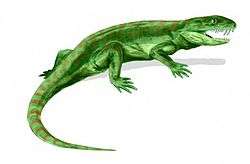Eothyrididae
| Eothyrididae Temporal range: Early Permian, 295–290 Ma | |
|---|---|
 | |
| life restoration of Eothyris parkeyi, body shape is conjectural since only the skull is known | |
| Scientific classification | |
| Kingdom: | Animalia |
| Phylum: | Chordata |
| Clade: | Synapsida |
| Clade: | †Caseasauria |
| Family: | †Eothyrididae Romer and Price, 1940 |
The Eothyrididae were a small group of very primitive, insectivorous synapsids. Only two genera are known, Eothyris and Oedaleops, both from the early Permian of North America. Their main distinguishing feature is the large caniniform tooth in front of the maxilla.
Eothyridids share with the Caseidae a number of specialised features associated with the morphology of the snout and external naris and it is likely that they were ancestral to them. The two together form the clade Caseasauria.
Eothyris is known from a single skull specimen; Oedaleops is known from three partial skulls and some parts of some limbs. The skulls are approximately 6 centimeters in length, suggesting that the total length of the animals was under 1 meter.
Both species were found in the lower Permian in what is today North America. In modern cladistics, the Eothyrididae are considered to be a basal group within the Caseasauria. Caseasauria forms a sister group of the Eupelycosauria, out of which the Therapsids (the "mammal-like reptiles") evolved.
See also
References
- Carroll, R. L. (1988), Vertebrate Paleontology and Evolution, WH Freeman & Co.
- Reisz, R. R., 1986, Handbuch der Paläoherpetologie – Encyclopedia of Paleoherpetology, Part 17A Pelycosauria Verlag Dr. Friedrich Pfeil, ISBN 3-89937-032-5
- Romer, AS & Price L.I (1940), Review of the Pelycosauria. Geol. Soc. Amer. Spec. Papers 28: 1-538.
External links
| |||||||||||||||||||||||||||||||||||||||||||||||||||||||||||||||||||||||
